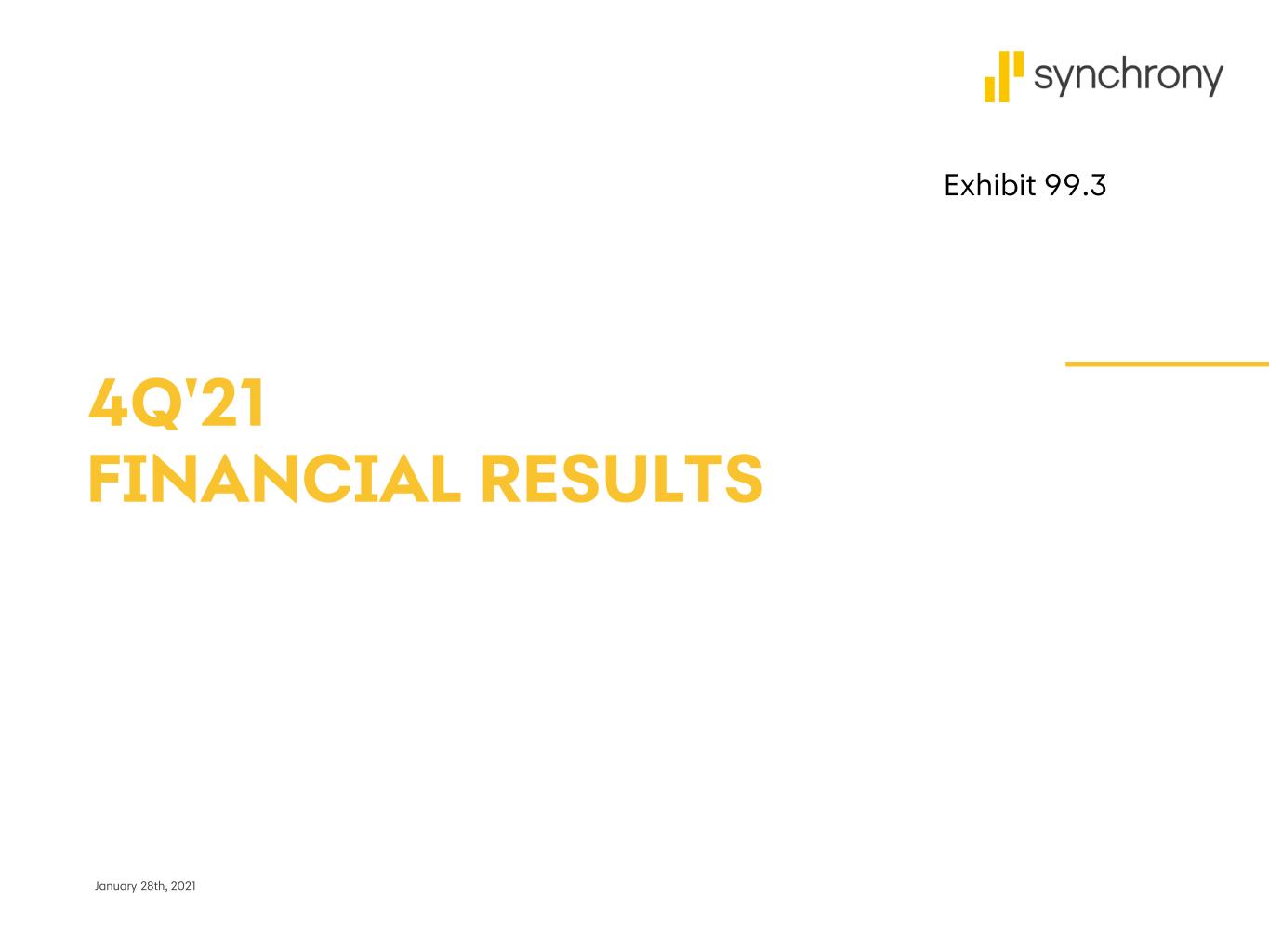
4Q'21 FINANCIAL RESULTS January 28th, 2021 Exhibit 99.3
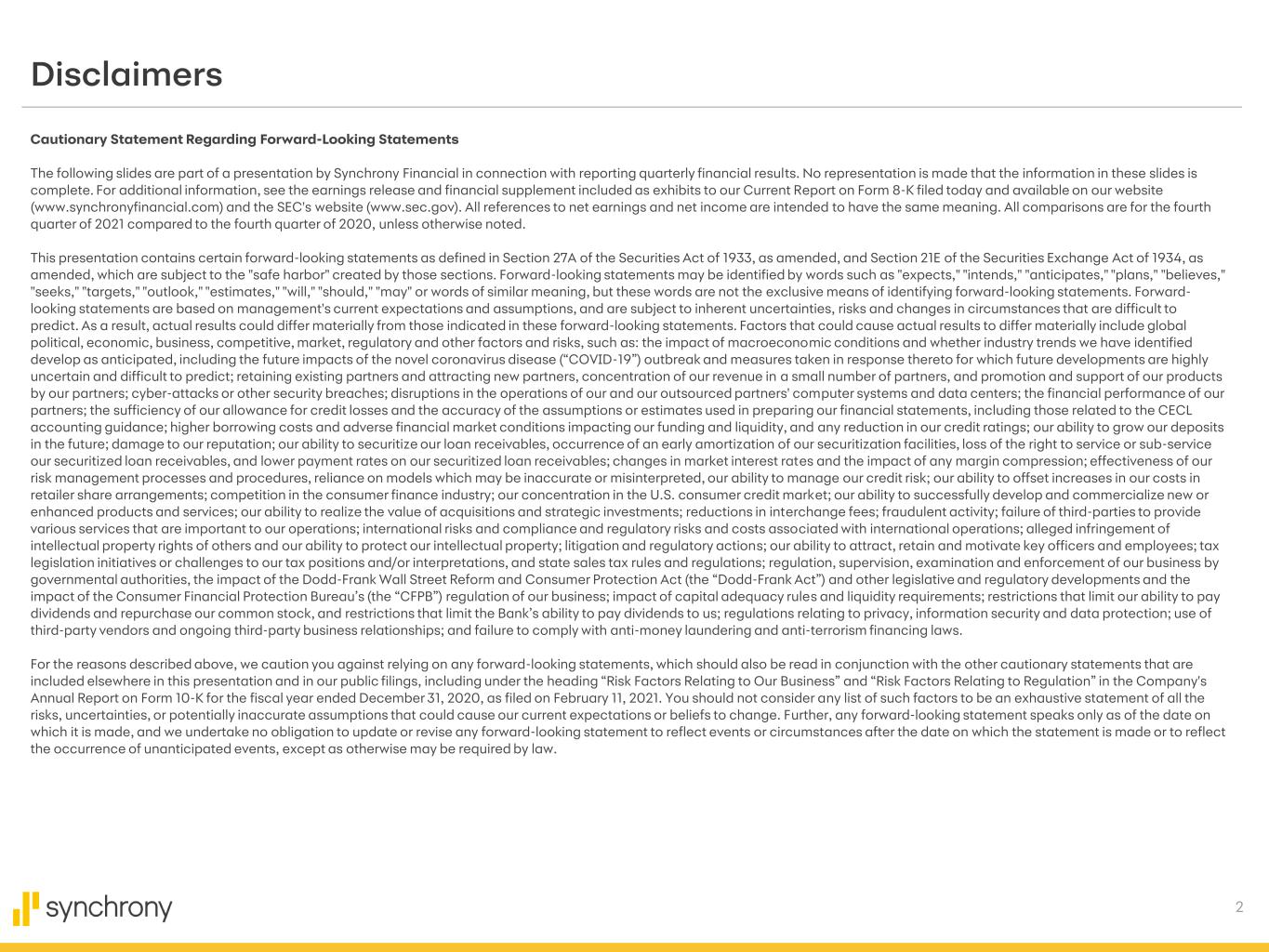
2 Cautionary Statement Regarding Forward-Looking Statements The following slides are part of a presentation by Synchrony Financial in connection with reporting quarterly financial results. No representation is made that the information in these slides is complete. For additional information, see the earnings release and financial supplement included as exhibits to our Current Report on Form 8-K filed today and available on our website (www.synchronyfinancial.com) and the SEC's website (www.sec.gov). All references to net earnings and net income are intended to have the same meaning. All comparisons are for the fourth quarter of 2021 compared to the fourth quarter of 2020, unless otherwise noted. This presentation contains certain forward-looking statements as defined in Section 27A of the Securities Act of 1933, as amended, and Section 21E of the Securities Exchange Act of 1934, as amended, which are subject to the "safe harbor" created by those sections. Forward-looking statements may be identified by words such as "expects," "intends," "anticipates," "plans," "believes," "seeks," "targets," "outlook," "estimates," "will," "should," "may" or words of similar meaning, but these words are not the exclusive means of identifying forward-looking statements. Forward- looking statements are based on management's current expectations and assumptions, and are subject to inherent uncertainties, risks and changes in circumstances that are difficult to predict. As a result, actual results could differ materially from those indicated in these forward-looking statements. Factors that could cause actual results to differ materially include global political, economic, business, competitive, market, regulatory and other factors and risks, such as: the impact of macroeconomic conditions and whether industry trends we have identified develop as anticipated, including the future impacts of the novel coronavirus disease (“COVID-19”) outbreak and measures taken in response thereto for which future developments are highly uncertain and difficult to predict; retaining existing partners and attracting new partners, concentration of our revenue in a small number of partners, and promotion and support of our products by our partners; cyber-attacks or other security breaches; disruptions in the operations of our and our outsourced partners' computer systems and data centers; the financial performance of our partners; the sufficiency of our allowance for credit losses and the accuracy of the assumptions or estimates used in preparing our financial statements, including those related to the CECL accounting guidance; higher borrowing costs and adverse financial market conditions impacting our funding and liquidity, and any reduction in our credit ratings; our ability to grow our deposits in the future; damage to our reputation; our ability to securitize our loan receivables, occurrence of an early amortization of our securitization facilities, loss of the right to service or sub-service our securitized loan receivables, and lower payment rates on our securitized loan receivables; changes in market interest rates and the impact of any margin compression; effectiveness of our risk management processes and procedures, reliance on models which may be inaccurate or misinterpreted, our ability to manage our credit risk; our ability to offset increases in our costs in retailer share arrangements; competition in the consumer finance industry; our concentration in the U.S. consumer credit market; our ability to successfully develop and commercialize new or enhanced products and services; our ability to realize the value of acquisitions and strategic investments; reductions in interchange fees; fraudulent activity; failure of third-parties to provide various services that are important to our operations; international risks and compliance and regulatory risks and costs associated with international operations; alleged infringement of intellectual property rights of others and our ability to protect our intellectual property; litigation and regulatory actions; our ability to attract, retain and motivate key officers and employees; tax legislation initiatives or challenges to our tax positions and/or interpretations, and state sales tax rules and regulations; regulation, supervision, examination and enforcement of our business by governmental authorities, the impact of the Dodd-Frank Wall Street Reform and Consumer Protection Act (the “Dodd-Frank Act”) and other legislative and regulatory developments and the impact of the Consumer Financial Protection Bureau’s (the “CFPB”) regulation of our business; impact of capital adequacy rules and liquidity requirements; restrictions that limit our ability to pay dividends and repurchase our common stock, and restrictions that limit the Bank’s ability to pay dividends to us; regulations relating to privacy, information security and data protection; use of third-party vendors and ongoing third-party business relationships; and failure to comply with anti-money laundering and anti-terrorism financing laws. For the reasons described above, we caution you against relying on any forward-looking statements, which should also be read in conjunction with the other cautionary statements that are included elsewhere in this presentation and in our public filings, including under the heading “Risk Factors Relating to Our Business” and “Risk Factors Relating to Regulation” in the Company's Annual Report on Form 10-K for the fiscal year ended December 31, 2020, as filed on February 11, 2021. You should not consider any list of such factors to be an exhaustive statement of all the risks, uncertainties, or potentially inaccurate assumptions that could cause our current expectations or beliefs to change. Further, any forward-looking statement speaks only as of the date on which it is made, and we undertake no obligation to update or revise any forward-looking statement to reflect events or circumstances after the date on which the statement is made or to reflect the occurrence of unanticipated events, except as otherwise may be required by law. Disclaimers
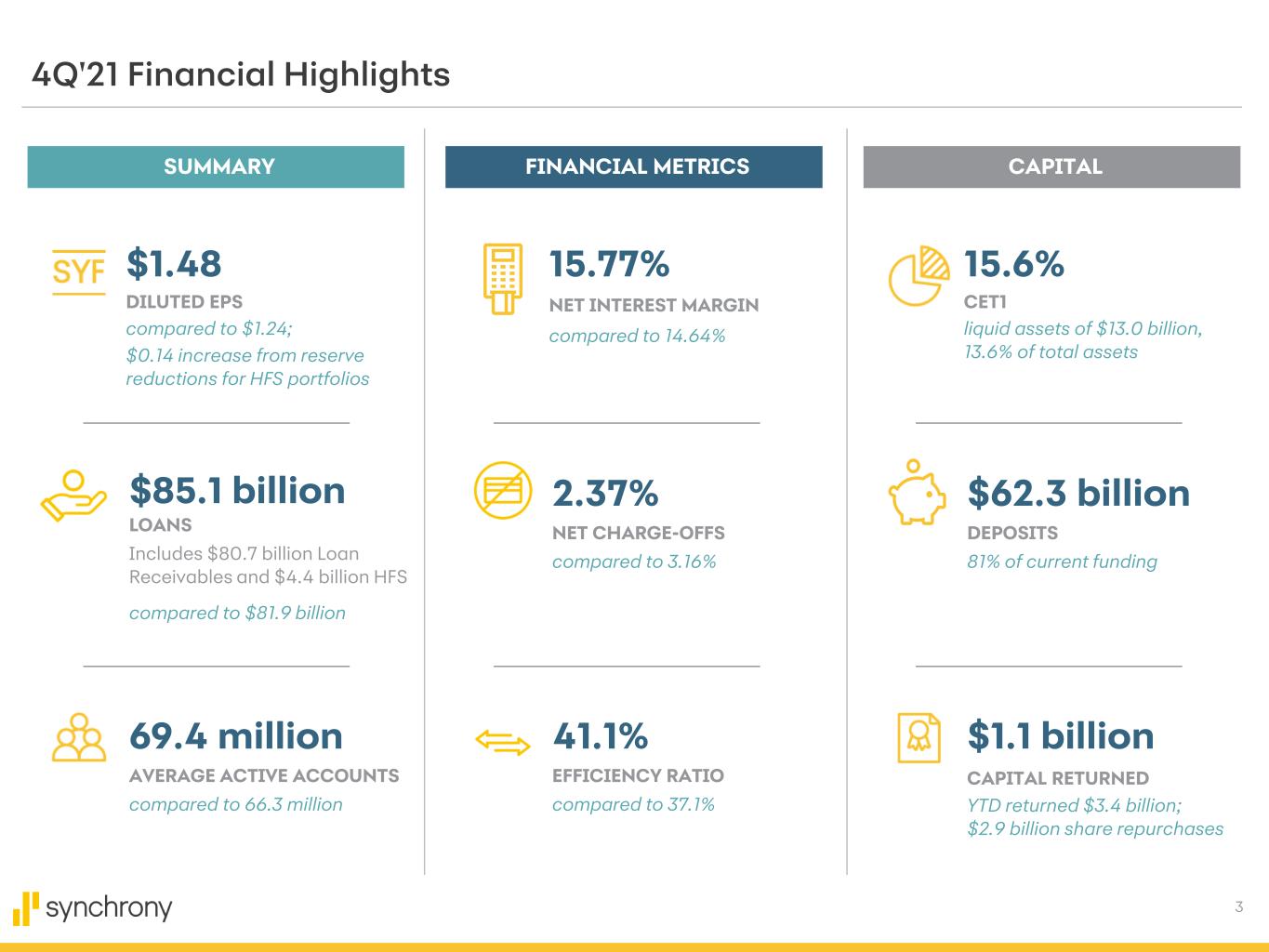
3 $1.48 DILUTED EPS compared to $1.24; $0.14 increase from reserve reductions for HFS portfolios 15.77% NET INTEREST MARGIN compared to 14.64% 15.6% CET1 liquid assets of $13.0 billion, 13.6% of total assets SUMMARY FINANCIAL METRICS CAPITAL 4Q'21 Financial Highlights $85.1 billion LOANS Includes $80.7 billion Loan Receivables and $4.4 billion HFS compared to $81.9 billion $62.3 billion DEPOSITS 81% of current funding 2.37% NET CHARGE-OFFS compared to 3.16% 69.4 million AVERAGE ACTIVE ACCOUNTS compared to 66.3 million $1.1 billion CAPITAL RETURNED YTD returned $3.4 billion; $2.9 billion share repurchases 41.1% EFFICIENCY RATIO compared to 37.1%
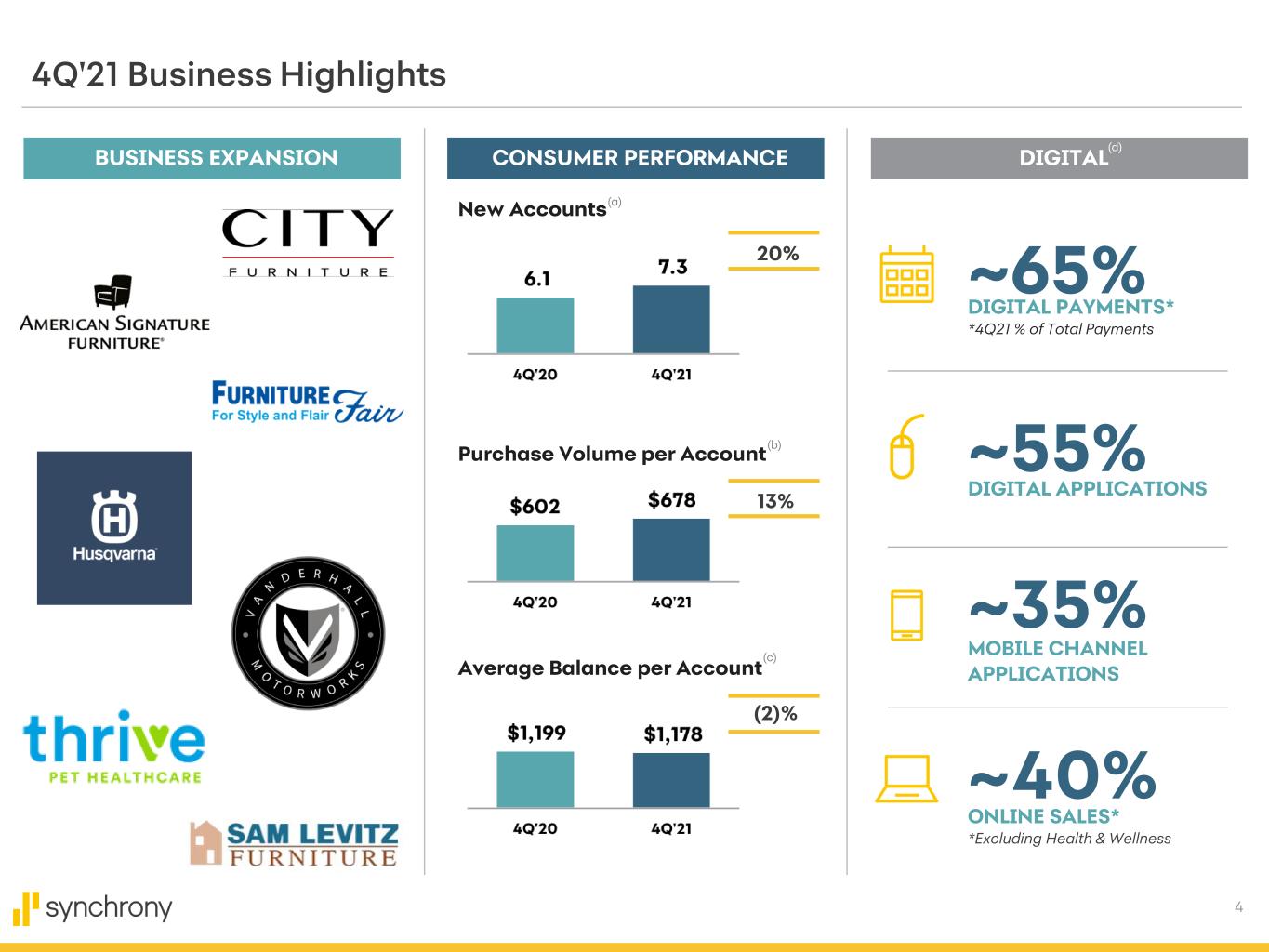
4 ~65% 4Q'21 Business Highlights BUSINESS EXPANSION CONSUMER PERFORMANCE DIGITAL 20% 13% (2)% New Accounts Purchase Volume per Account Average Balance per Account (a) (b) (c) ~40% ONLINE SALES* *Excluding Health & Wellness DIGITAL APPLICATIONS ~35% MOBILE CHANNEL APPLICATIONS DIGITAL PAYMENTS* *4Q21 % of Total Payments ~55% (d)
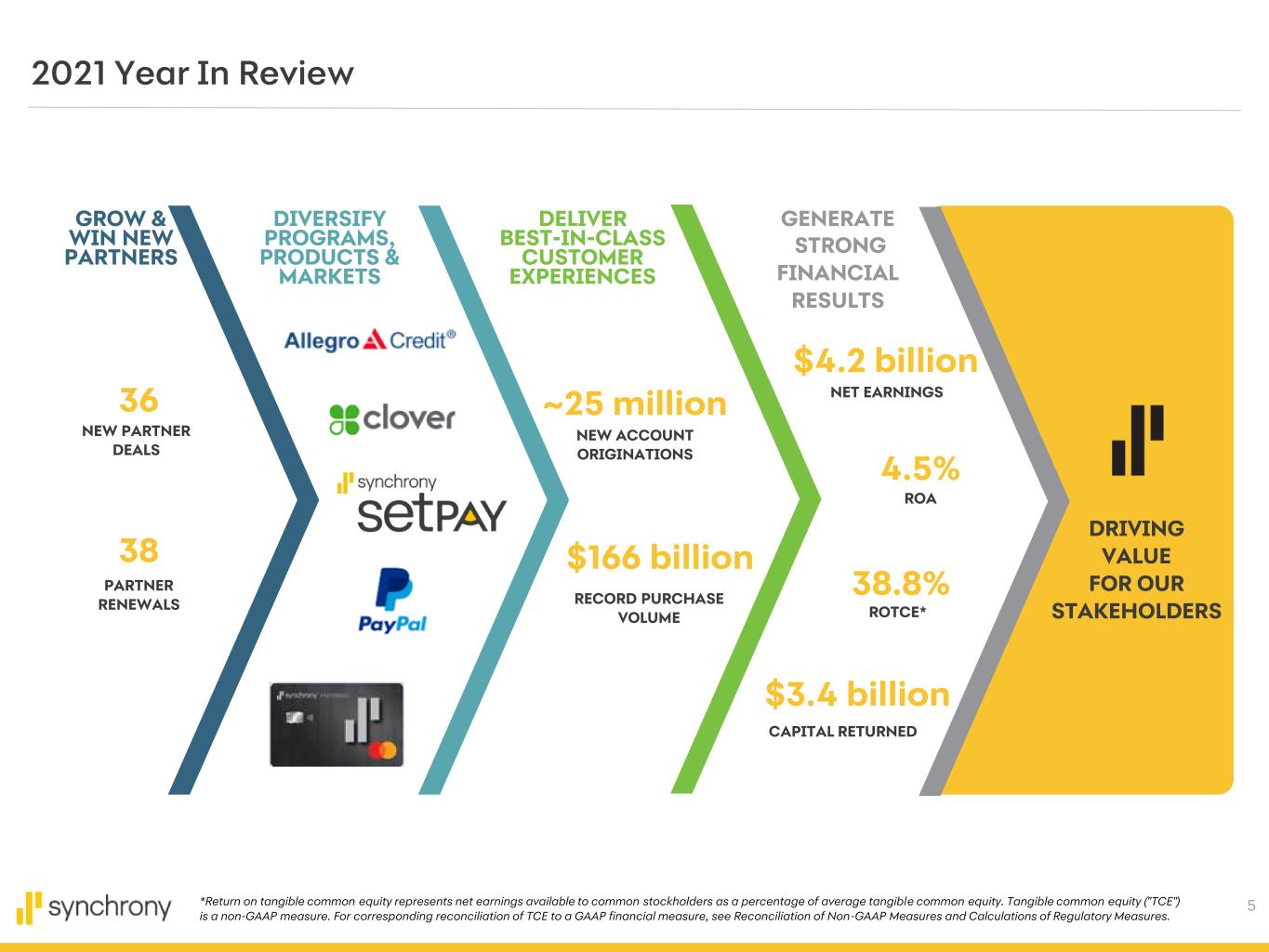
5 GENERATE STRONG FINANCIAL RESULTS DIVERSIFY PROGRAMS, PRODUCTS & MARKETS GROW & WIN NEW PARTNERS DELIVER BEST-IN-CLASS CUSTOMER EXPERIENCES 36 NEW PARTNER DEALS ~25 million NEW ACCOUNT ORIGINATIONS 2021 Year In Review 38 PARTNER RENEWALS 38.8% ROTCE* 4.5% ROA $4.2 billion NET EARNINGS $166 billion RECORD PURCHASE VOLUME $3.4 billion CAPITAL RETURNED DRIVING VALUE FOR OUR STAKEHOLDERS *Return on tangible common equity represents net earnings available to common stockholders as a percentage of average tangible common equity. Tangible common equity ("TCE") is a non-GAAP measure. For corresponding reconciliation of TCE to a GAAP financial measure, see Reconciliation of Non-GAAP Measures and Calculations of Regulatory Measures.
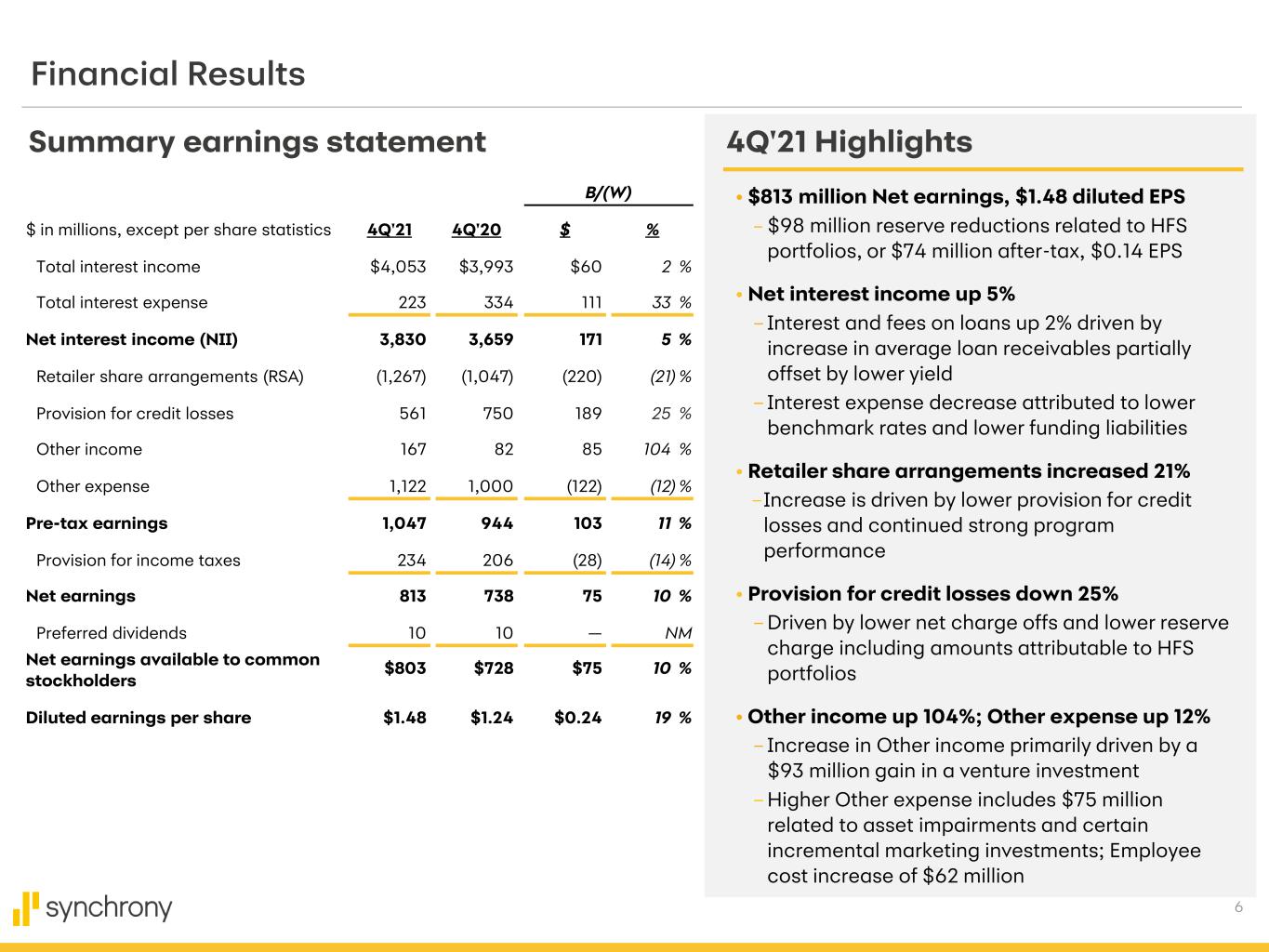
6 B/(W) $ in millions, except per share statistics 4Q'21 4Q'20 $ % Total interest income $4,053 $3,993 $60 2 % Total interest expense 223 334 111 33 % Net interest income (NII) 3,830 3,659 171 5 % Retailer share arrangements (RSA) (1,267) (1,047) (220) (21) % Provision for credit losses 561 750 189 25 % Other income 167 82 85 104 % Other expense 1,122 1,000 (122) (12) % Pre-tax earnings 1,047 944 103 11 % Provision for income taxes 234 206 (28) (14) % Net earnings 813 738 75 10 % Preferred dividends 10 10 — NM Net earnings available to common stockholders $803 $728 $75 10 % Diluted earnings per share $1.48 $1.24 $0.24 19 % Financial Results 4Q'21 HighlightsSummary earnings statement • $813 million Net earnings, $1.48 diluted EPS – $98 million reserve reductions related to HFS portfolios, or $74 million after-tax, $0.14 EPS • Net interest income up 5% – Interest and fees on loans up 2% driven by increase in average loan receivables partially offset by lower yield – Interest expense decrease attributed to lower benchmark rates and lower funding liabilities • Retailer share arrangements increased 21% –Increase is driven by lower provision for credit losses and continued strong program performance • Provision for credit losses down 25% – Driven by lower net charge offs and lower reserve charge including amounts attributable to HFS portfolios • Other income up 104%; Other expense up 12% – Increase in Other income primarily driven by a $93 million gain in a venture investment – Higher Other expense includes $75 million related to asset impairments and certain incremental marketing investments; Employee cost increase of $62 million
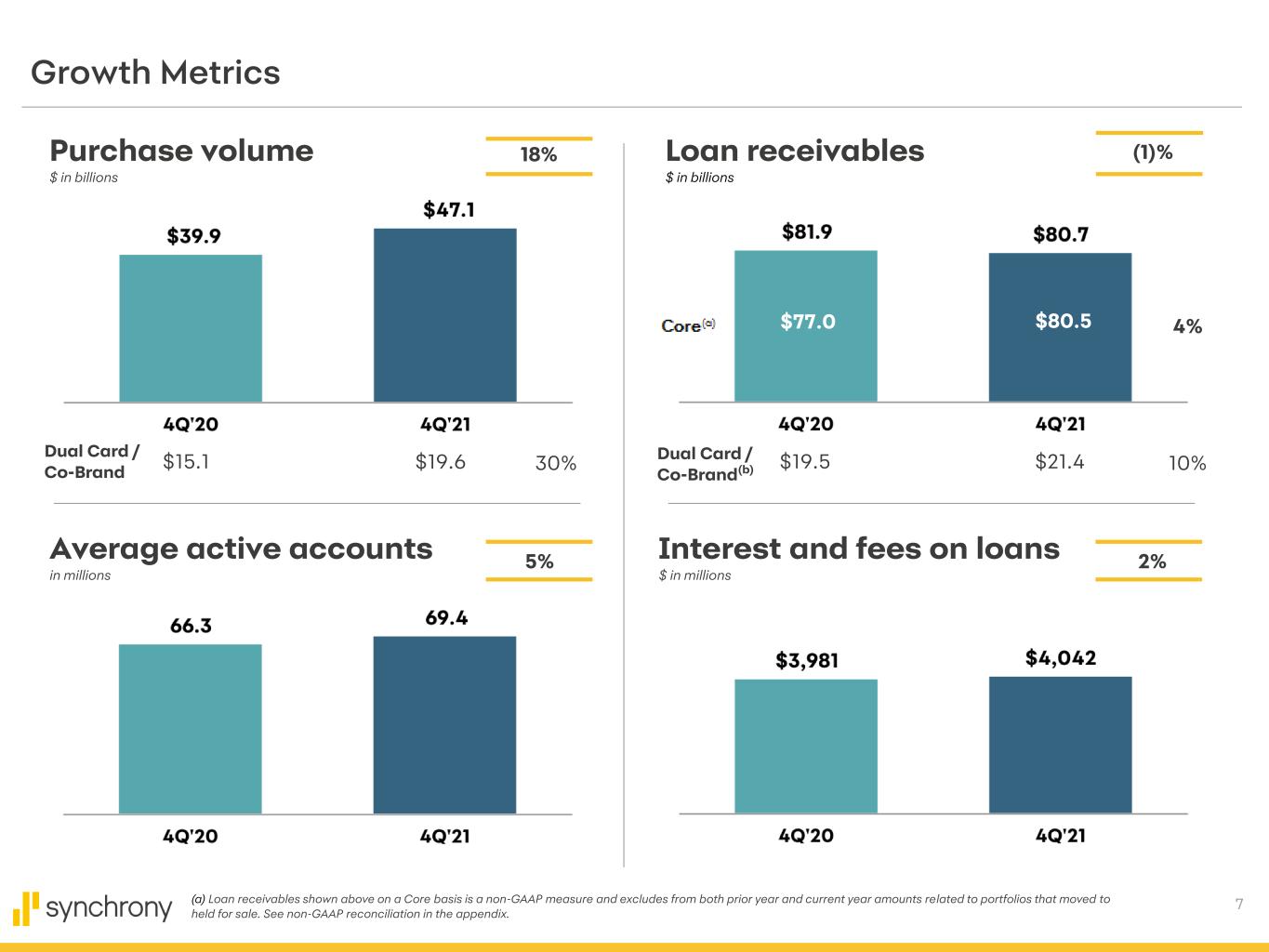
7 $44.0 Dual Card / Co-Brand Growth Metrics 59.4 62.1 $74.5 $76.3 $3,586 $3,641 $33.5 $39.0 4% 18% 5% 2% (1)%Purchase volume $ in billions Loan receivables $ in billions Average active accounts in millions Interest and fees on loans $ in millions $15.1 30%$19.6 10%$19.5 $21.4 $77.0 $80.5 (a) Loan receivables shown above on a Core basis is a non-GAAP measure and excludes from both prior year and current year amounts related to portfolios that moved to held for sale. See non-GAAP reconciliation in the appendix. Dual Card / Co-Brand(b)
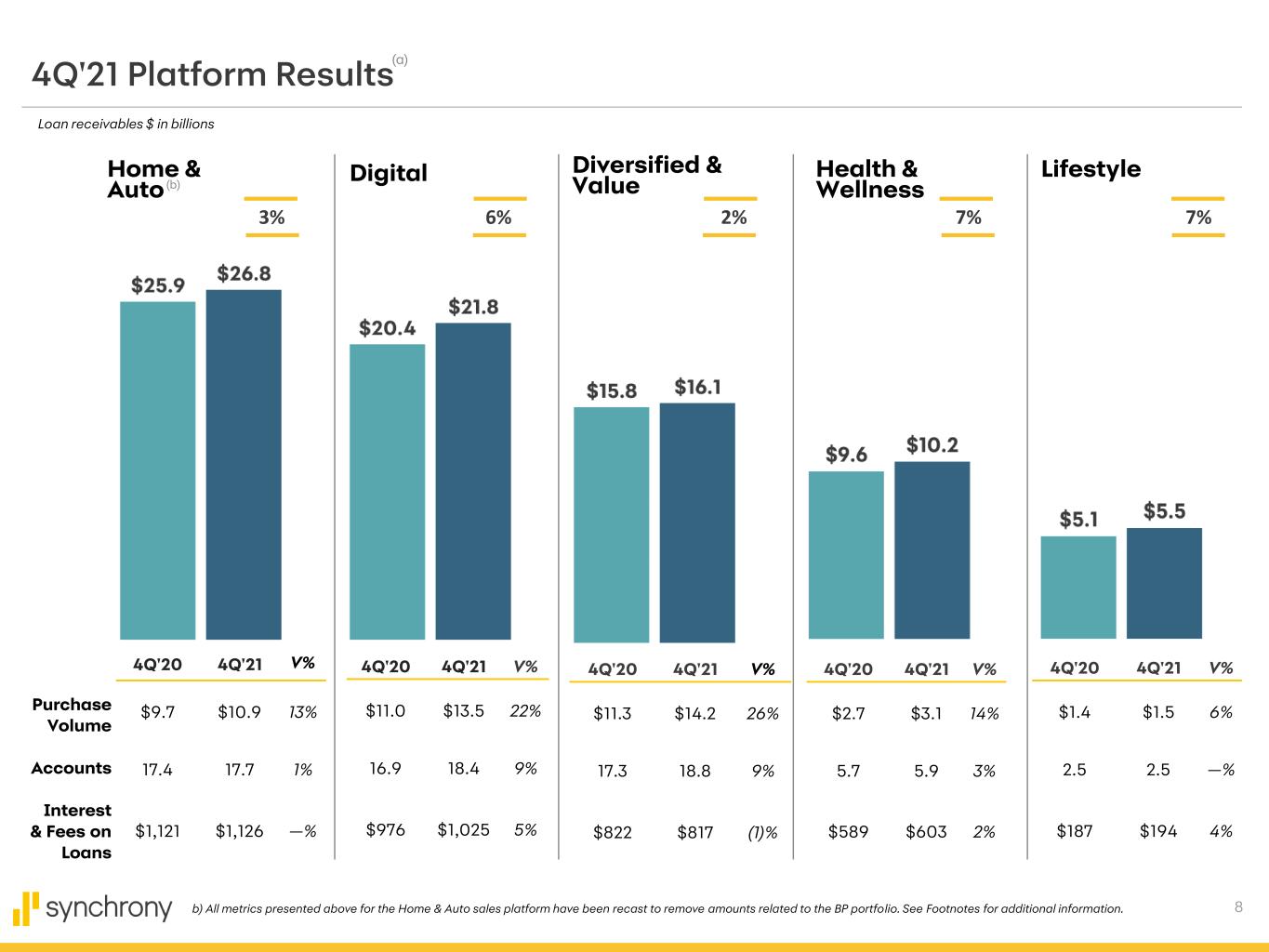
8 Home & Auto 4Q'21 Platform Results Digital Diversified & Value Health & Wellness Lifestyle 3% 2% 7% 7%6% 4Q'20 4Q'21 V% $9.7 $10.9 13% 17.4 17.7 1% $1,121 $1,126 —% 4Q'20 4Q'21 V% $11.0 $13.5 22% 16.9 18.4 9% $976 $1,025 5% 4Q'20 4Q'21 V% $11.3 $14.2 26% 17.3 18.8 9% $822 $817 (1)% 4Q'20 4Q'21 V% $2.7 $3.1 14% 5.7 5.9 3% $589 $603 2% 4Q'20 4Q'21 V% $1.4 $1.5 6% 2.5 2.5 —% $187 $194 4% Loan receivables $ in billions (a) Purchase Volume Accounts Interest & Fees on Loans b) All metrics presented above for the Home & Auto sales platform have been recast to remove amounts related to the BP portfolio. See Footnotes for additional information. (b)

9 Net Interest Income Net Interest Income $ in millions % of average interest-earning assets • Net interest income increased 5% – Interest and fees on loans up 2% driven by higher average loan receivables partially offset by lower yield – Interest expense decrease attributed to lower benchmark rates and lower funding liabilities • Net interest margin (NIM) up 113 bps – Mix of Interest-earnings assets: 96 bps – Loan receivable mix as a percent of total Earning Assets increased from 79.9% to 84.9% – Interest-bearing liabilities cost: 42 bps – Total cost decreased 51 bps to 1.18% primarily driven by lower benchmark rates – Loan receivables yield: (26) bps – Loan receivables yield of 19.61%, down 32 bps • 4Q’21 payment rate is ~290 bps higher compared to 5-year historical average 4Q'21 Highlights 4Q'20 NIM 14.64% Mix of Interest-earning assets 0.96% Interest-bearing liabilities cost 0.42% Loan receivables yield (0.26)% Liquidity portfolio yield 0.01% 4Q'21 NIM 15.77% NIM Walk Payment Rate Trends (a) 5% Avg. (‘16-‘20)
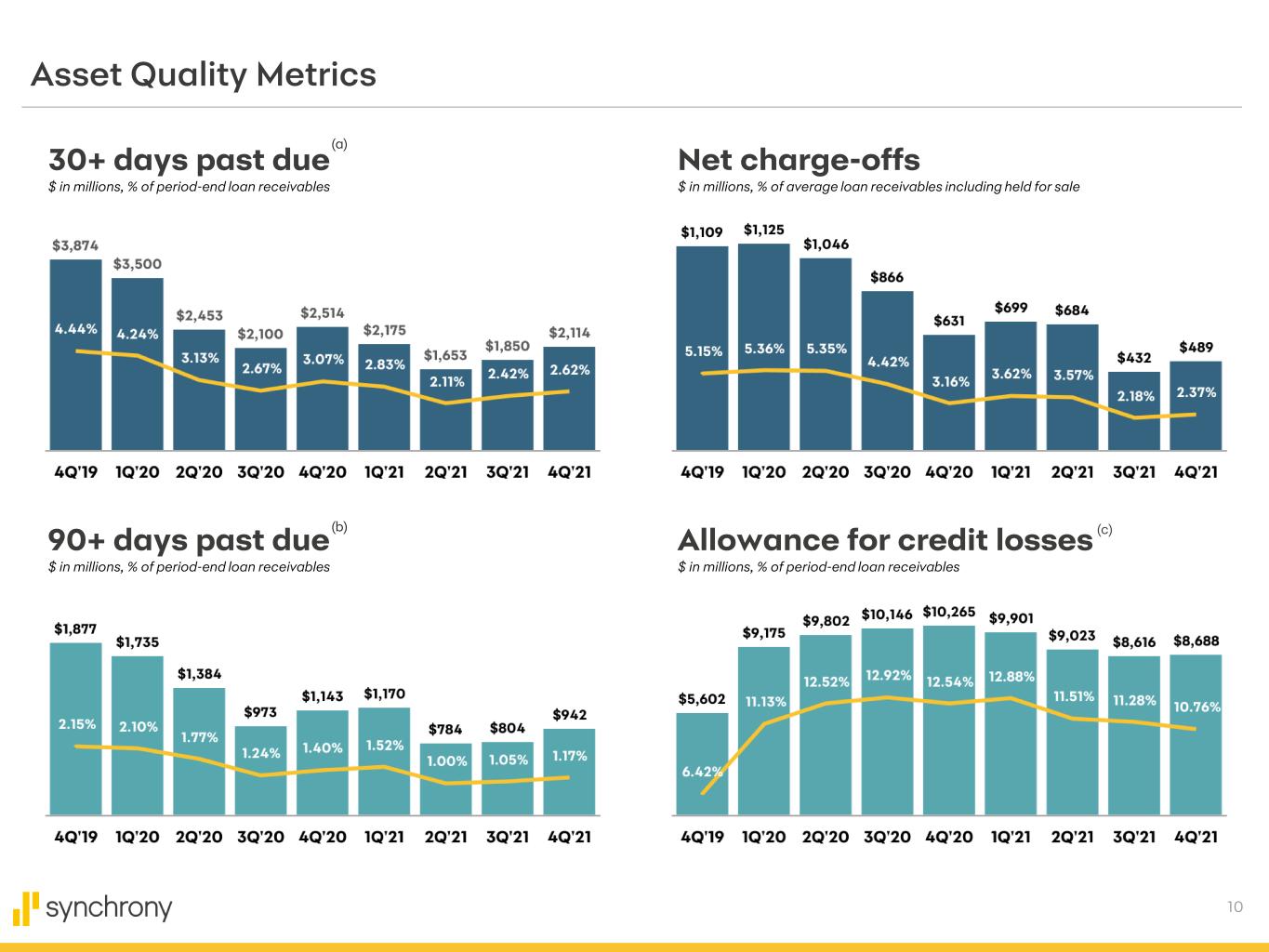
10 Asset Quality Metrics Allowance for credit losses $ in millions, % of period-end loan receivables Net charge-offs $ in millions, % of average loan receivables including held for sale 30+ days past due $ in millions, % of period-end loan receivables 90+ days past due $ in millions, % of period-end loan receivables (c) (a) (b)

11 B/(W) 4Q'20 4Q'21 V$ V% Employee costs $347 $409 $(62) (18)% Professional fees $186 $207 $(21) (11)% Marketing/BD $139 $167 $(28) (20)% Information processing $128 $143 $(15) (12)% Other $200 $196 $4 2% Other expense $1,000 $1,122 $(122) (12)% Efficiency(a) 37.1% 41.1% 4.0 pts. Other Expense Other expense $ in millions 4Q'21 Highlights12% • Other expense up 12% – Higher other expense includes $75 million related to asset impairments and certain incremental marketing investments – Employee cost increase of $62 million attributable to higher hourly wages and higher incentive compensation as 2020 was lower due to the pandemic – Higher purchase volume and technology investments driving increased expense in Professional fees and Information processing • Efficiency ratio 41.1% vs. 37.1% prior year – Increase in ratio driven by higher expenses and lower revenue resulting from elevated payment rates – Excluding the impacts of the $93 million investment gain and the $75 million discussed above, the efficiency ratio would be 39.7%

12 Tier 1 Capital + Credit Loss Reserve Ratio* Capital ratios Funding, Capital and Liquidity Funding sources $ in billions V$ $(0.8) $(0.5) $(0.5) V% Liquidity $ in billions CET1 Capital Ratio Tier 1 Capital Ratio Total Capital Ratio * The “Tier 1 Capital + Credit Loss Reserve Ratio” is the sum of our “Tier 1 Capital” and “Allowance for Credit Losses,” divided by our “Total Risk-Weighted Assets”. Tier 1. Capital and Risk-Weighted Assets are adjusted to reflect the fully phased-in impact of CECL. These adjusted metrics are non-GAAP measures, see non-GAAP reconciliation in appendix. Unsecured Securitization Deposits Deposits 80% 81% +1 pts. Securitization 10% 10% 0 pts. Unsecured 10% 9% (1) pt. Liquid assets $18.3 $13.0 Undrawn credit facilities 5.4 2.7 Total liquidity $23.7 $15.7 % of Total assets 24.7% 16.4% (a) (b)

13 2022 Outlook Key Driver Full Year Framework Purchase Volume • Continued strength in Purchase Volume across all sales platforms • Anticipate moderation as consumer savings rate and payment rate declines Net Interest Margin • Generally consistent with 2H’21 including seasonal trends • Proceeds from portfolio conveyance creates some excess liquidity in Q2 and Q3 having a negative impact on NIM • Higher Interest & Fee yield offset by higher reversals Net Charge Offs • DQs & NCOs: increase from current levels in NCOs and delinquencies • Peak DQs expected to be in Q4 RSA • Continued elevation from strong program performance and Purchase Volume growth • Moderation will begin as NCOs rise Operating Expenses • Expect quarterly expense dollars to be generally consistent with the 4Q’21, excluding asset impairments and certain marketing items HFS Portfolios • Anticipate closing on HFS portfolios in Q2 • Generate a one time gain of ~$130 million • Anticipate incremental investments to fully offset gain; No EPS impact Capital • CECL transition reduces CET1 by 62bps(a) • Expect to return capital in aggressive but prudent manner, subject to regulatory and market considerations (comments and trends in comparison to 2021, except where noted)
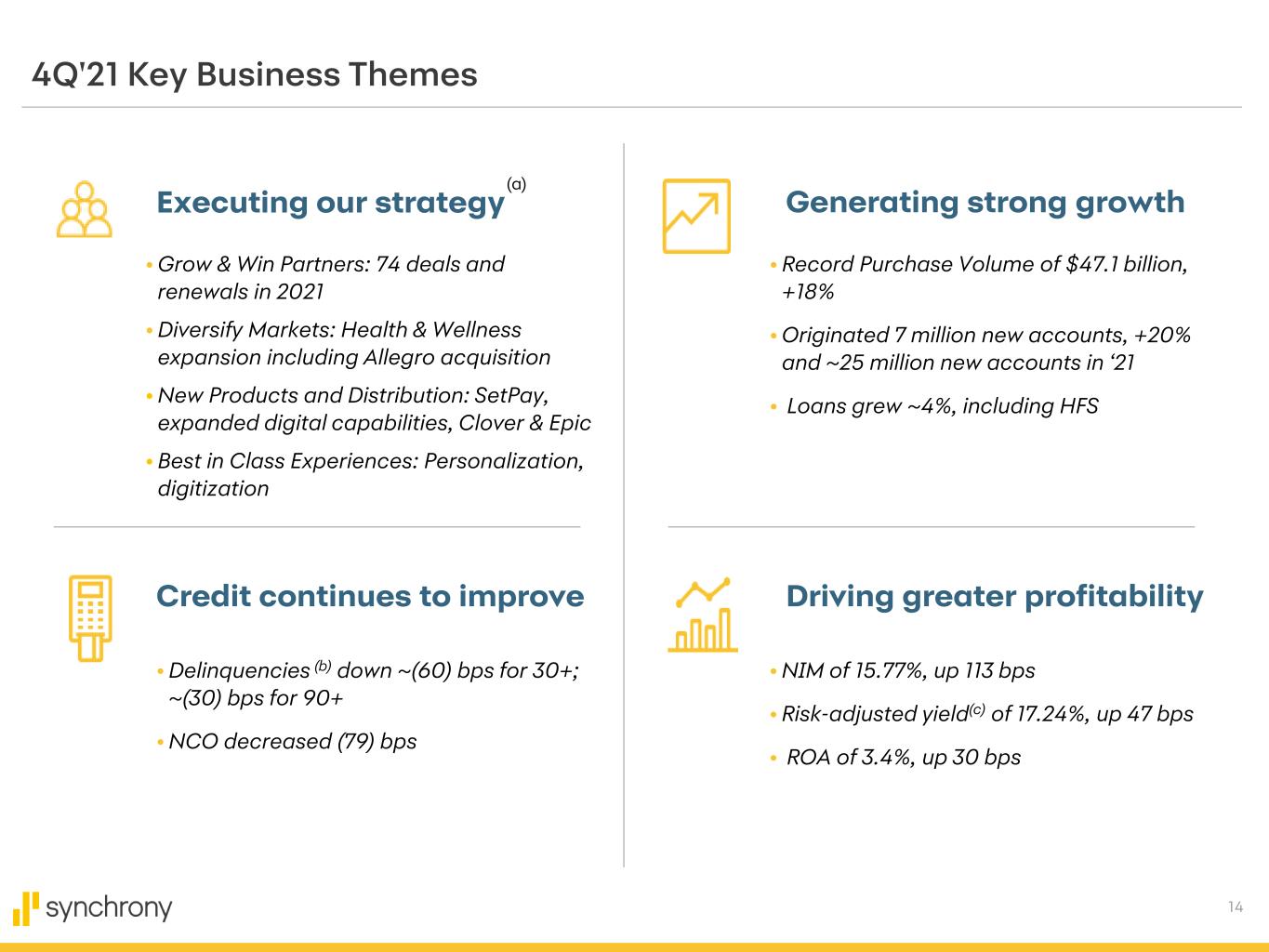
14 4Q'21 Key Business Themes Executing our strategy Generating strong growth Driving greater profitabilityCredit continues to improve • Grow & Win Partners: 74 deals and renewals in 2021 • Diversify Markets: Health & Wellness expansion including Allegro acquisition • New Products and Distribution: SetPay, expanded digital capabilities, Clover & Epic • Best in Class Experiences: Personalization, digitization • Record Purchase Volume of $47.1 billion, +18% • Originated 7 million new accounts, +20% and ~25 million new accounts in ‘21 • Loans grew ~4%, including HFS • Delinquencies (b) down ~(60) bps for 30+; ~(30) bps for 90+ • NCO decreased (79) bps • NIM of 15.77%, up 113 bps • Risk-adjusted yield(c) of 17.24%, up 47 bps • ROA of 3.4%, up 30 bps (a)
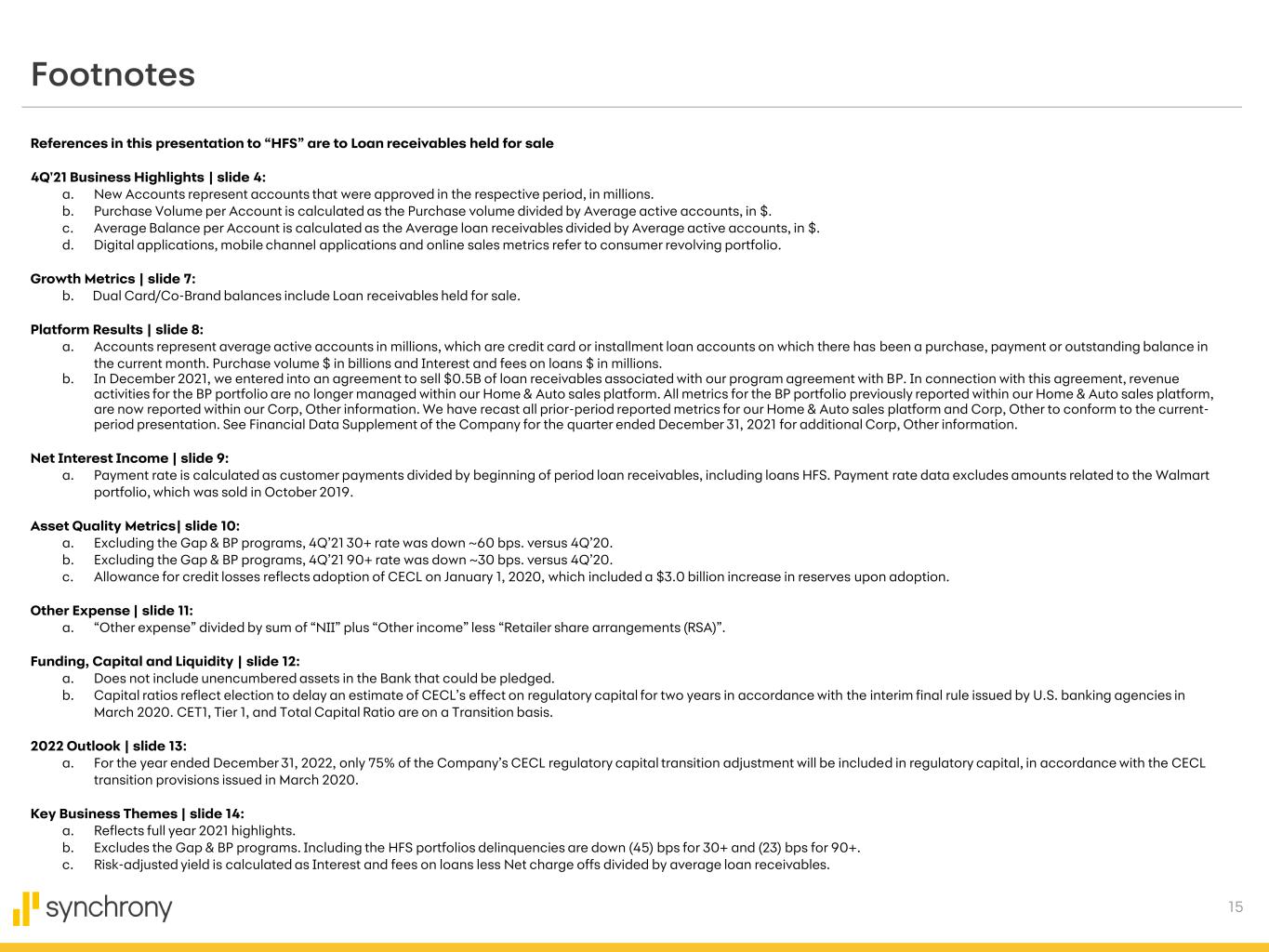
15 Footnotes References in this presentation to “HFS” are to Loan receivables held for sale 4Q'21 Business Highlights | slide 4: a. New Accounts represent accounts that were approved in the respective period, in millions. b. Purchase Volume per Account is calculated as the Purchase volume divided by Average active accounts, in $. c. Average Balance per Account is calculated as the Average loan receivables divided by Average active accounts, in $. d. Digital applications, mobile channel applications and online sales metrics refer to consumer revolving portfolio. Growth Metrics | slide 7: b. Dual Card/Co-Brand balances include Loan receivables held for sale. Platform Results | slide 8: a. Accounts represent average active accounts in millions, which are credit card or installment loan accounts on which there has been a purchase, payment or outstanding balance in the current month. Purchase volume $ in billions and Interest and fees on loans $ in millions. b. In December 2021, we entered into an agreement to sell $0.5B of loan receivables associated with our program agreement with BP. In connection with this agreement, revenue activities for the BP portfolio are no longer managed within our Home & Auto sales platform. All metrics for the BP portfolio previously reported within our Home & Auto sales platform, are now reported within our Corp, Other information. We have recast all prior-period reported metrics for our Home & Auto sales platform and Corp, Other to conform to the current- period presentation. See Financial Data Supplement of the Company for the quarter ended December 31, 2021 for additional Corp, Other information. Net Interest Income | slide 9: a. Payment rate is calculated as customer payments divided by beginning of period loan receivables, including loans HFS. Payment rate data excludes amounts related to the Walmart portfolio, which was sold in October 2019. Asset Quality Metrics| slide 10: a. Excluding the Gap & BP programs, 4Q’21 30+ rate was down ~60 bps. versus 4Q’20. b. Excluding the Gap & BP programs, 4Q’21 90+ rate was down ~30 bps. versus 4Q’20. c. Allowance for credit losses reflects adoption of CECL on January 1, 2020, which included a $3.0 billion increase in reserves upon adoption. Other Expense | slide 11: a. “Other expense” divided by sum of “NII” plus “Other income” less “Retailer share arrangements (RSA)”. Funding, Capital and Liquidity | slide 12: a. Does not include unencumbered assets in the Bank that could be pledged. b. Capital ratios reflect election to delay an estimate of CECL’s effect on regulatory capital for two years in accordance with the interim final rule issued by U.S. banking agencies in March 2020. CET1, Tier 1, and Total Capital Ratio are on a Transition basis. 2022 Outlook | slide 13: a. For the year ended December 31, 2022, only 75% of the Company’s CECL regulatory capital transition adjustment will be included in regulatory capital, in accordance with the CECL transition provisions issued in March 2020. Key Business Themes | slide 14: a. Reflects full year 2021 highlights. b. Excludes the Gap & BP programs. Including the HFS portfolios delinquencies are down (45) bps for 30+ and (23) bps for 90+. c. Risk-adjusted yield is calculated as Interest and fees on loans less Net charge offs divided by average loan receivables.
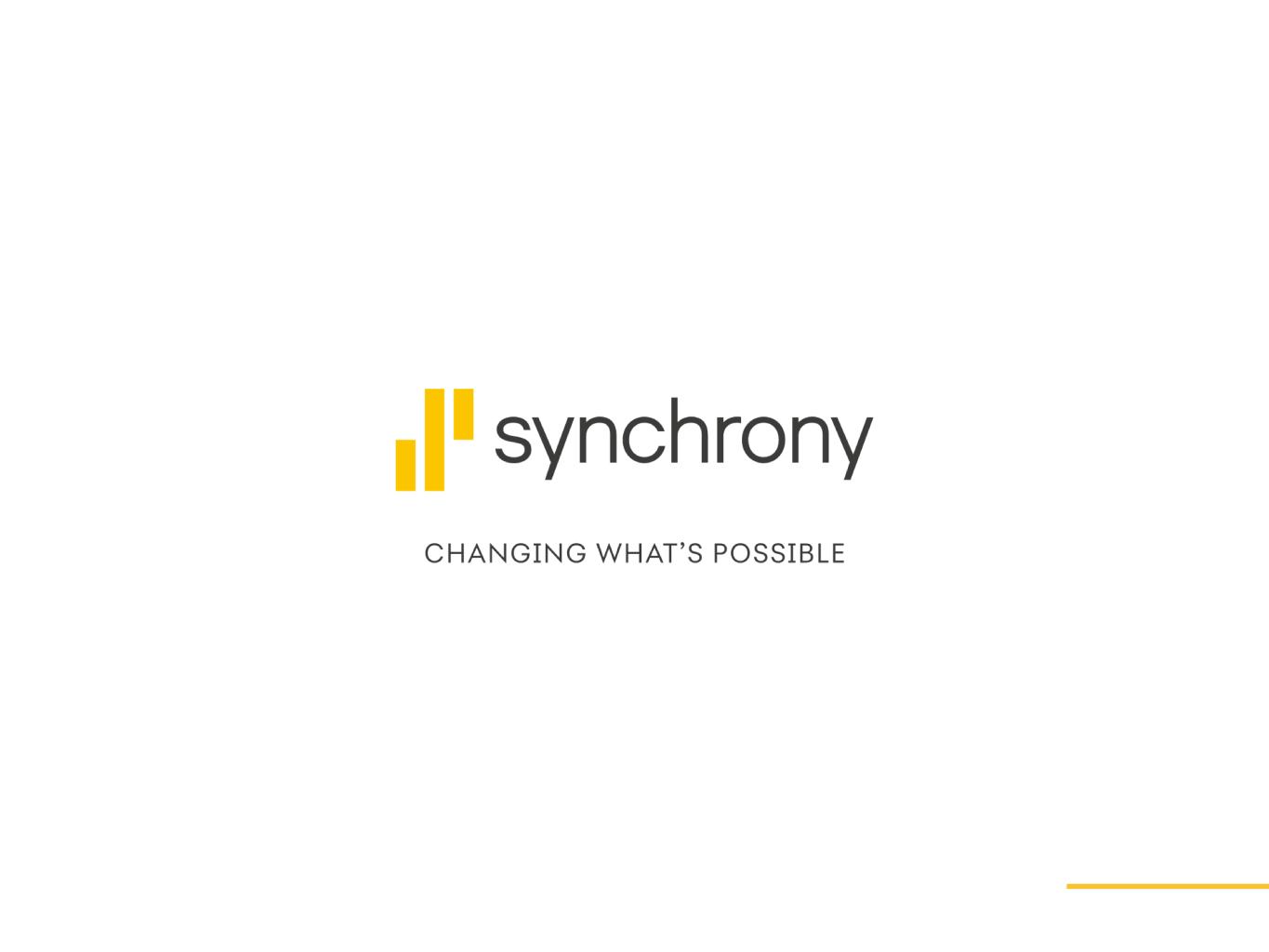
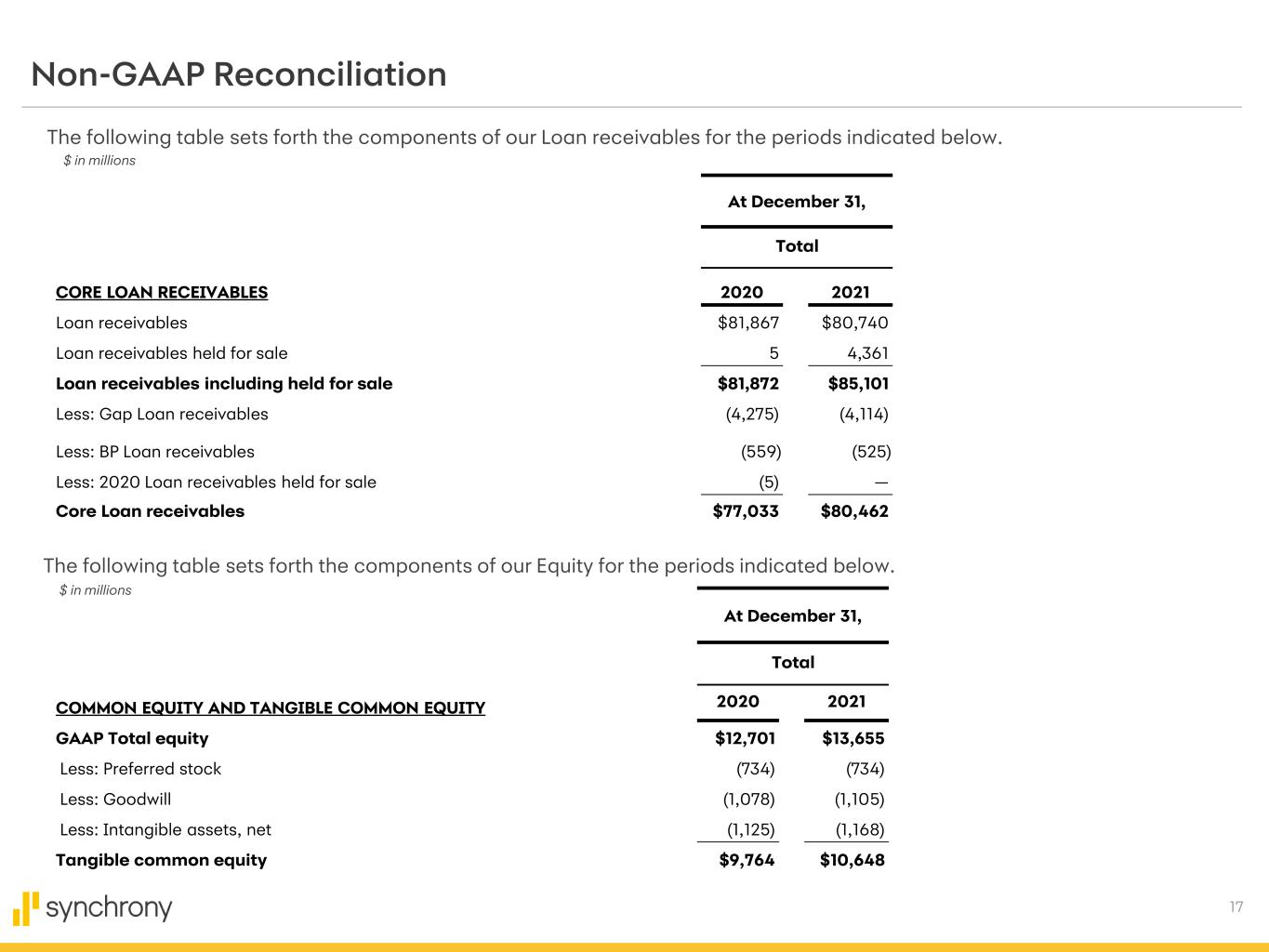
17 Non-GAAP Reconciliation The following table sets forth the components of our Loan receivables for the periods indicated below. $ in millions At December 31, Total CORE LOAN RECEIVABLES 2020 2021 Loan receivables $81,867 $80,740 Loan receivables held for sale 5 4,361 Loan receivables including held for sale $81,872 $85,101 Less: Gap Loan receivables (4,275) (4,114) Less: BP Loan receivables (559) (525) Less: 2020 Loan receivables held for sale (5) — Core Loan receivables $77,033 $80,462 At December 31, Total COMMON EQUITY AND TANGIBLE COMMON EQUITY 2020 2021 GAAP Total equity $12,701 $13,655 Less: Preferred stock (734) (734) Less: Goodwill (1,078) (1,105) Less: Intangible assets, net (1,125) (1,168) Tangible common equity $9,764 $10,648 The following table sets forth the components of our Equity for the periods indicated below. $ in millions
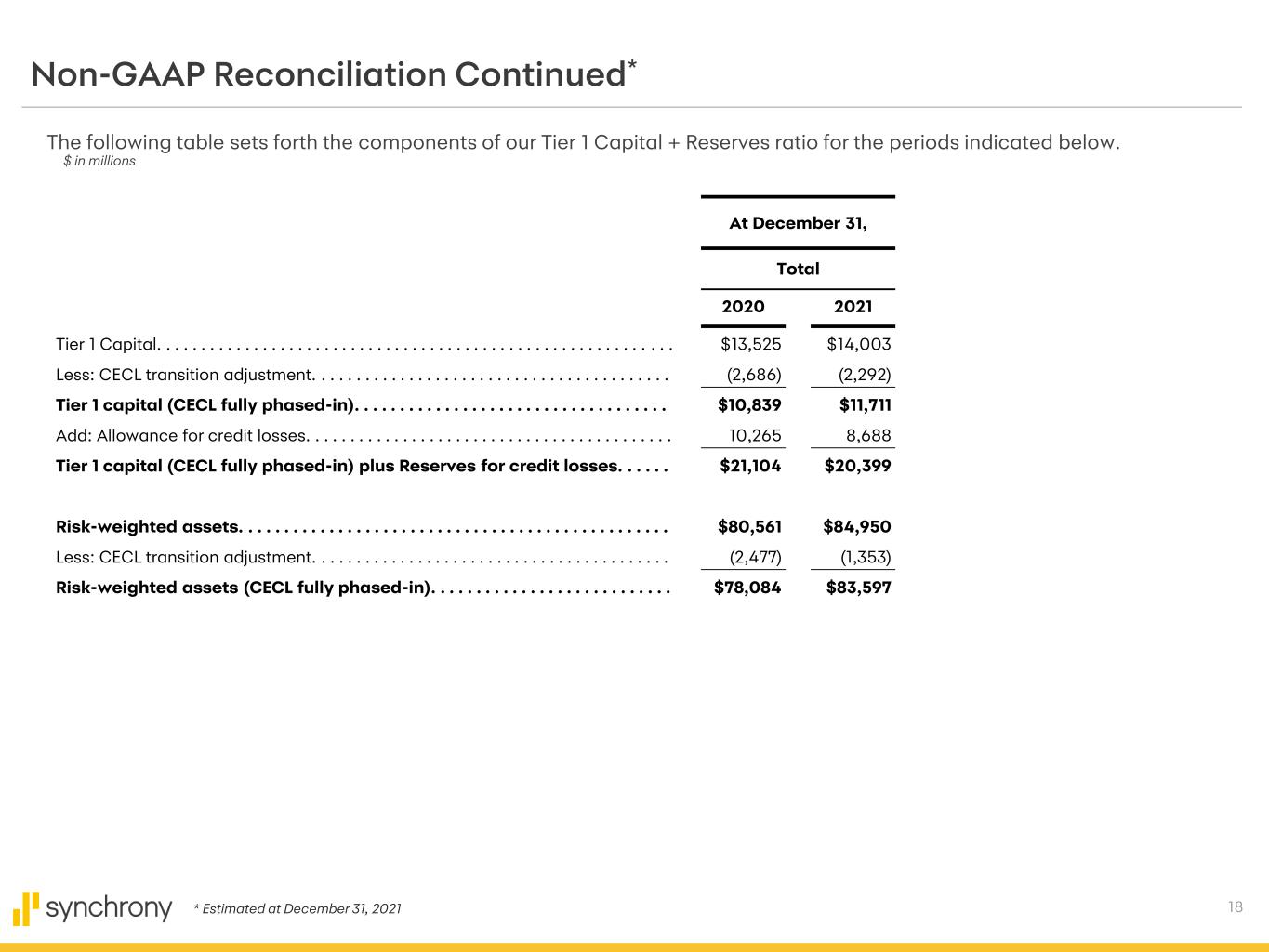
18 Non-GAAP Reconciliation Continued* The following table sets forth the components of our Tier 1 Capital + Reserves ratio for the periods indicated below. $ in millions At December 31, Total 2020 2021 Tier 1 Capital. . . . . . . . . . . . . . . . . . . . . . . . . . . . . . . . . . . . . . . . . . . . . . . . . . . . . . . . . . . $13,525 $14,003 Less: CECL transition adjustment. . . . . . . . . . . . . . . . . . . . . . . . . . . . . . . . . . . . . . . . . (2,686) (2,292) Tier 1 capital (CECL fully phased-in). . . . . . . . . . . . . . . . . . . . . . . . . . . . . . . . . . . $10,839 $11,711 Add: Allowance for credit losses. . . . . . . . . . . . . . . . . . . . . . . . . . . . . . . . . . . . . . . . . . 10,265 8,688 Tier 1 capital (CECL fully phased-in) plus Reserves for credit losses. . . . . . $21,104 $20,399 Risk-weighted assets. . . . . . . . . . . . . . . . . . . . . . . . . . . . . . . . . . . . . . . . . . . . . . . . $80,561 $84,950 Less: CECL transition adjustment. . . . . . . . . . . . . . . . . . . . . . . . . . . . . . . . . . . . . . . . . (2,477) (1,353) Risk-weighted assets (CECL fully phased-in). . . . . . . . . . . . . . . . . . . . . . . . . . . $78,084 $83,597 * Estimated at December 31, 2021